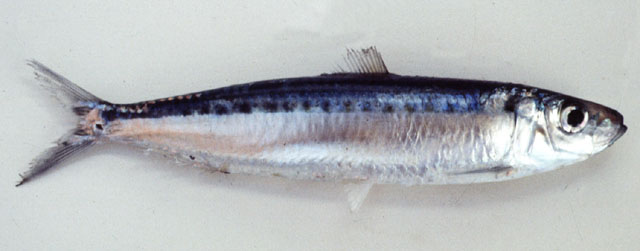| Clupeidae (Herrings, shads, sardines, menhadens), subfamily: Dorosomatinae |
| 27 cm SL (male/unsexed); max. reported age: 8 years |
|
reef-associated; depth range 10 - 75 m |
| Indo-West Pacific: Red Sea and Mozambique to the Philippines, north to Taiwan and Okinawa (Japan), south to New Guinea, the Arafura Sea (Ref. 9819), northern Australia, and Fiji. |
|
Dorsal spines (total): 0-0; Dorsal soft rays (total): 13-21; Anal spines: 0-0; Anal soft rays: 12-23. Scutes not prominent. Distinguished from A. clupeoides and A. leiogaster by the presence of a series of 10 to 20 gold (in life) or black (on preservation) spots down the flank (but sometimes missing) and more lower gill rakers; from Sardinops species by the absence of a bony radiating striae on its operculum; from Sardinella species by its fewer pelvic fin rays and lower gill rakers. |
| Pelagic (Ref. 53568). A schooling species occurring in coastal waters and lagoons. In Panggang Island, Indonesia it was recorded in temperatures of 28.5-29.8°C and salinities of 31.6-32.3 ppt (Ref. 823). Feeds mainly on copepods, nauplii and zoea larvae, larval bivalves and gastropods, as well as Peridinium and Ceratium. Used as bait in the tuna fishery. |
|
Not Evaluated
(Ref. 96402)
|
| harmless |
|
Source and more info: www.fishbase.org. For personal, classroom, and other internal use only. Not for publication.
Page created by Jen, 05.08.02,
php script by kbanasihan 06/09/2010 ,
last modified by
dsantos, 20/08/10

